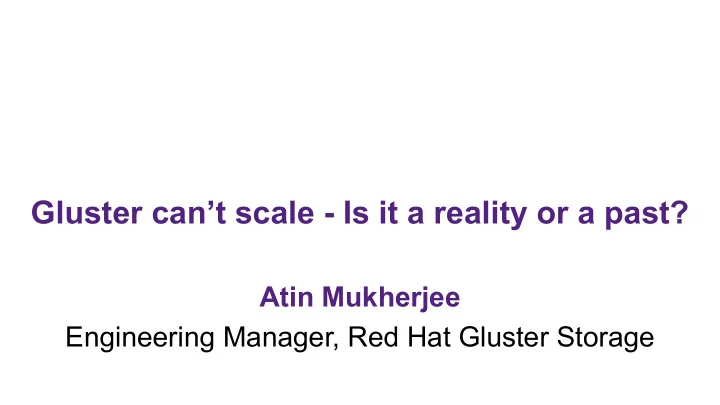

Gluster can’t scale - Is it a reality or a past? Atin Mukherjee Engineering Manager, Red Hat Gluster Storage
Agenda r Brief about GlusterFS r Scaling bottlenecks in Gluster r How did (and are) we overcoming them r Projects/features like GlusterD2, brick multiplexing, sub-directory fuse mount, flexi sub vol. r Q&A
What is GlusterFS ● A general purpose scale-out distributed file system. ● Aggregates storage exports over network interconnect to provide a single unified namespace. ● Filesystem is stackable and completely in userspace. ● Layered on disk file systems that support extended attributes.
Some key terminologies r Trusted Storage Pool (TSP) - Trusted Storage Pool (cluster) is a collection of storage servers. r Peer – Node in the cluster r Volume - A volume is a logical collection of bricks r Brick - A brick is the combination of a node and an export directory – for e.g. hostname:/dir
Present.. ● RHGS cluster of ~150 nodes run in production deployments (with some caveats) ● Community version - ~200-250 nodes (with some caveats) ● With OpenShift Deployments, ~600 volumes on a 3 node cluster. (Yes! Thanks to brick multiplexing feature)
Scaling bottlenecks ● Node scalability – Is 150 nodes deployment in hybrid cloud sufficient with the growing storage demand? – 1000 nodes cluster even be a reality? ● GD1 (GlusterD 1) ====> GD2 (GlusterD2) ● GD2 (released as tech preview with GlusterFS 4.0) will become the default management plane for Gluster in coming releases
Scaling bottlenecks – Node scalability ● GlusterD - Manages the cluster configuration for Gluster Peer membership management Elastic volume management Configuration consistency Distributed command execution (orchestration) Service management (manages Gluster daemons)
Scaling bottlenecks – Node scalability Limitations of GD1 ● Non linear node scalability – Lack of native ReST APIs – Code maintainability and easier feature integrations in the form of plugins – What’s in for GD2 ● Centralized store (etcd) – Better transaction framework – ReST API support – Intelligent Volume Provisioning –
Node scalability - GD2 Architecture
Scaling bottlenecks ● Volume scalability – Thousands of volumes in cluster? ● Brick Multiplexing
Volume scalability – Brick Multiplexing ● Brick Multiplexing (GlusterFS 3.10 onwards) – 1:1 process & brick ===> 1:Many process & bricks – Reduced resource (Port, Memory, CPU) consumption – Not a performance enhancer! – One of the gluster core salient features for container native storage’s success.
Other ways to scale ● Fuse based sub directory export (GlusterFS 3.12 onwards) – Single volume, sub directory based isolation for different clients – Namespace access control through auth.allow – Gluster snapshots need to work at volume level
Other ways to scale ● Gluster sub-vol (https://github.com/gluster/gluster-subvol) – Use subdirectories of Gluster volumes as persistent volumes in openshift.io – glfs-vol – a flex volume plugin to allow mounting Gluster subdirectories into containers. – Uses xfs quota for setting up quotas for the directory based space control.
Other scaling challenges ● Resource control ● Debugg-ability ● User experience
Q & A
Thank you! ● Reach us @ – gluster-devel@gluster.org gluster- users@gluster.org – IRC : #gluster, #gluster-dev @freenode
Recommend
More recommend